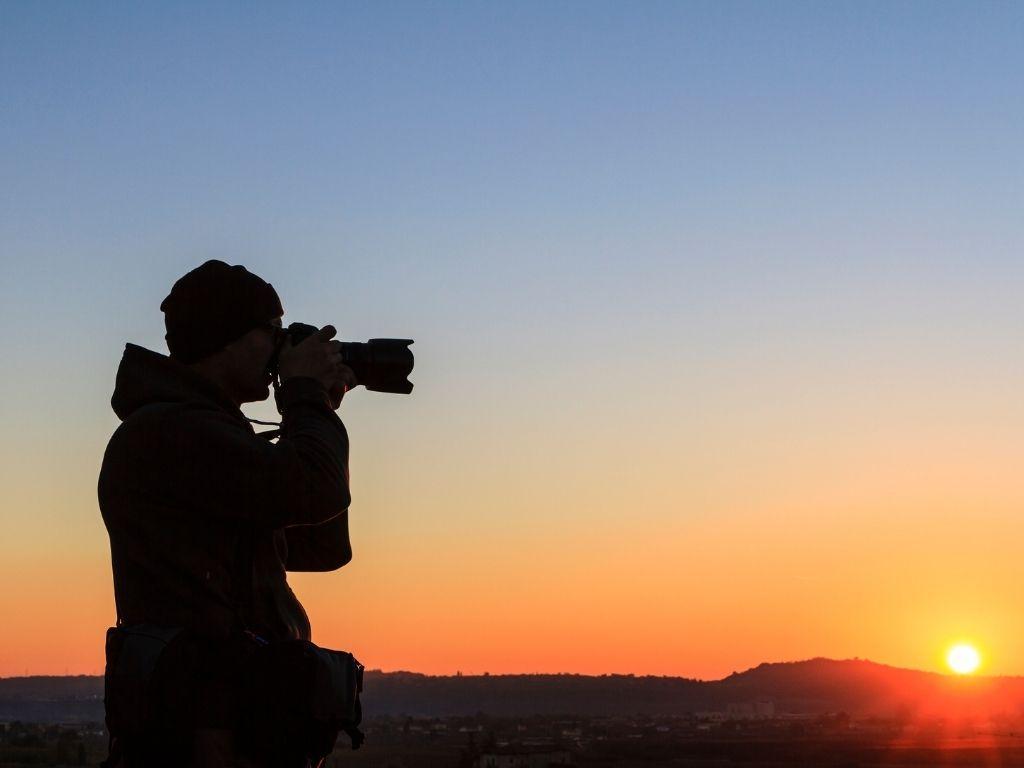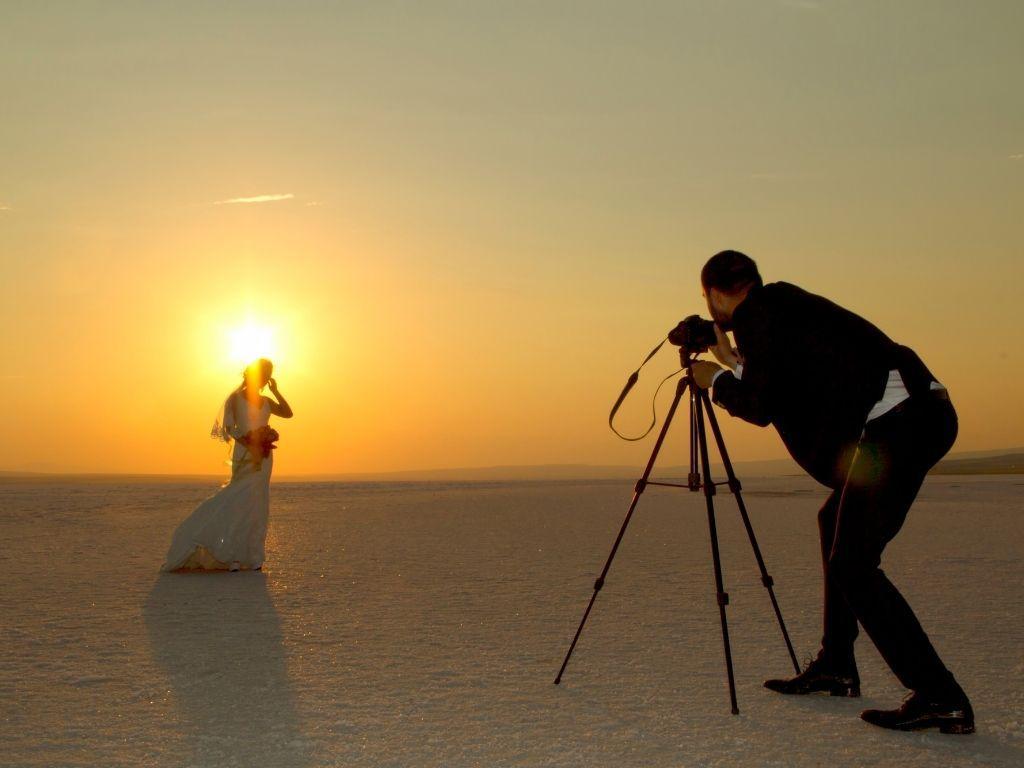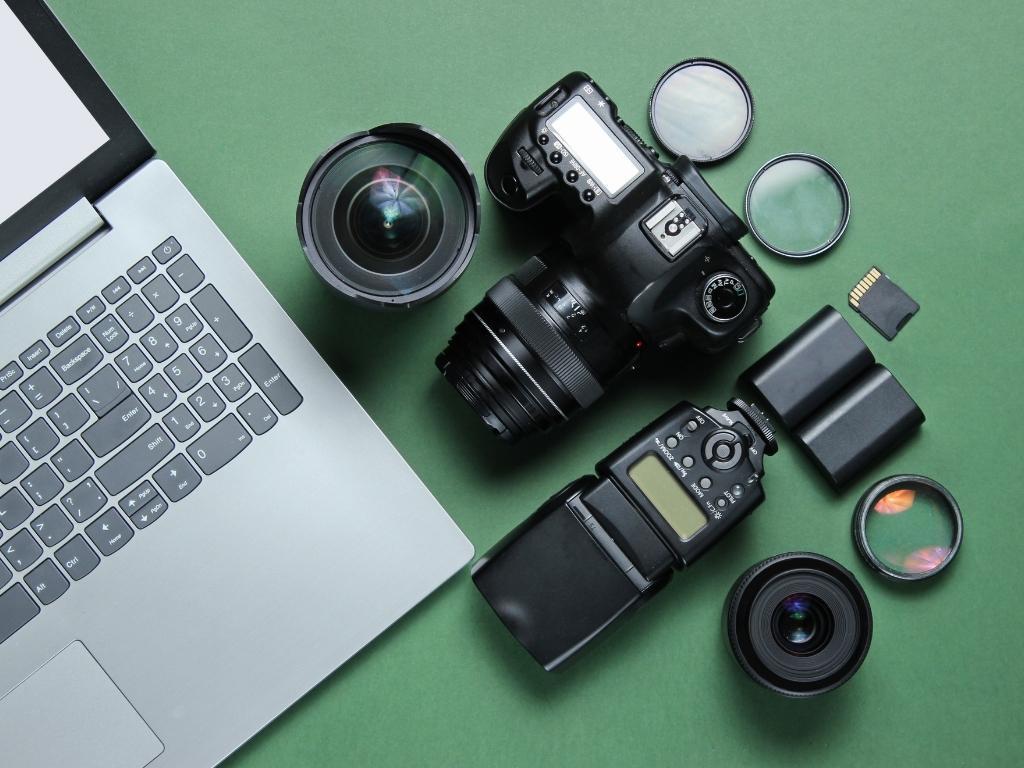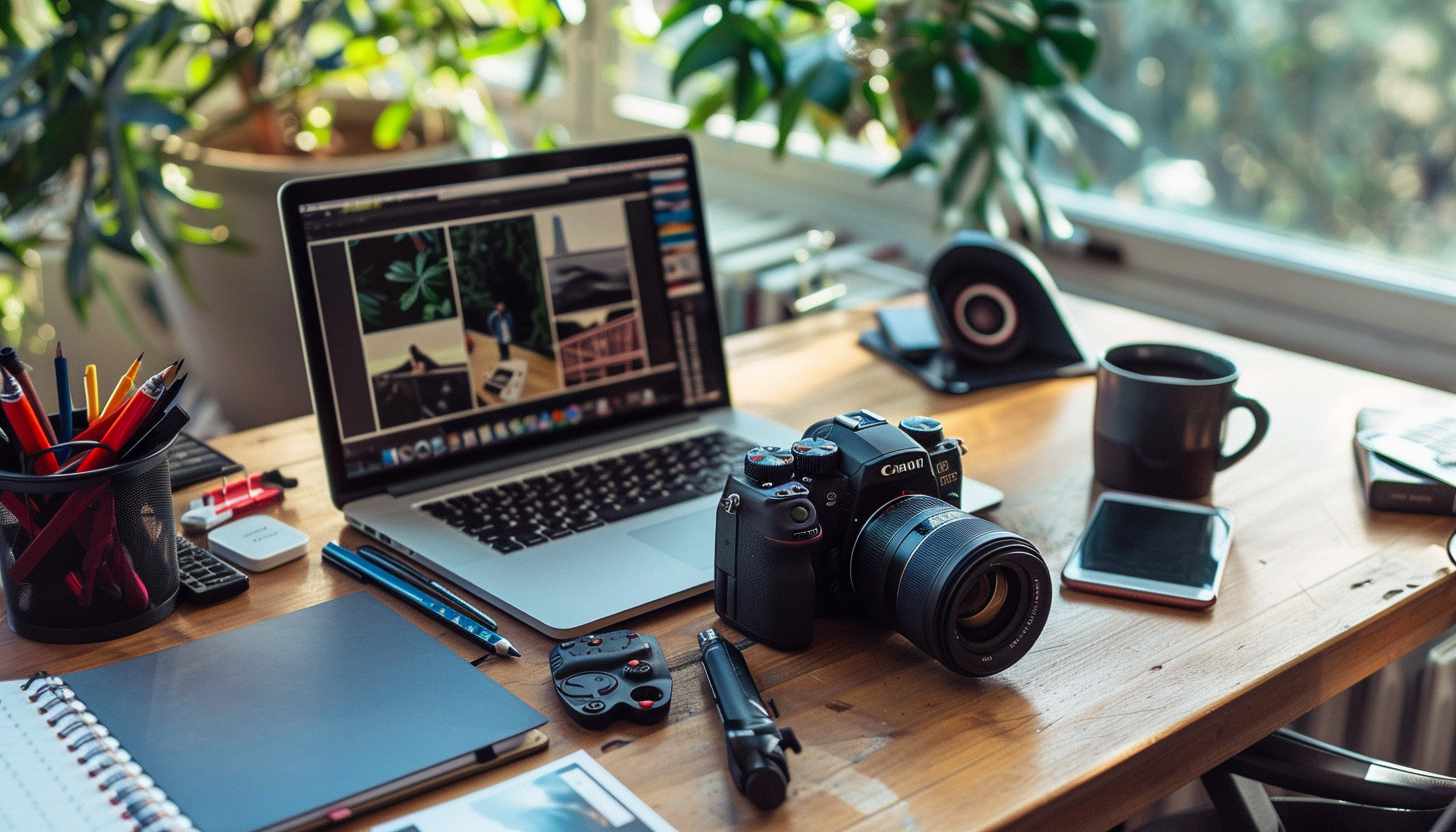Are you someone who loves taking photos? Is your camera roll filled with candid moments of your loved ones, breathtaking landscapes, and mouthwatering food photos? Do people keep telling you to start photography as a side hustle but you keep wondering how to start a photography business? Where do you even start?
Do you need fancy equipment? How do you find clients? And what about legal stuff like contracts and pricing? Relax. This guide will walk you through how to start a photography business step by step. By the time you’re done reading, you’ll have a clear roadmap to turn your camera into cash. Let’s get started!

How To Start A Photography Business In 8 Easy Steps
Ready to channel your inner photographer? Here’s our easy guide on how to start a photography business in easy steps.
Step 1: Pick Your Photography Niche (Because You Can’t Do It All)
Have you ever heard the saying, “Jack of all trades, master of none”? That applies big time in photography. If you try to be a wedding photographer, a product photographer, a real estate photographer and a pet photographer, you’ll spread yourself too thin and struggle to stand out.
Let’s Talk Niches
There are tons of ways to make money with photography, but here are some popular options:
- Wedding Photography: This one has big paychecks, but long hours and high-pressure situations.
- Portrait Photography: This includes headshots, family photos, and maternity shoots.
- Event Photography: Corporate gigs, concerts, birthdays etc. are included in this type and there’s lots of variety!
- Product Photography: This is perfect if you love working with brands and e-commerce businesses.
- Real Estate Photography: Realtors pay good money for stunning house photos.
- Stock Photography: Sell your images on sites like Shutterstock or Adobe Stock.
How To Choose The Right One For You
Here are a few questions you should ask yourself before you decide on a niche:
- What kind of photos do you love taking?
- What’s in demand in your area?
- Can you see yourself doing this full-time?
If you’re obsessed with capturing emotions, weddings might be your thing. If you love perfectly arranged setups, product photography could be your calling. Pick something that excites you because you’ll be doing a lot of it.

Step 2: Level Up Your Photography Skills (Because “Fix It in Post” Doesn’t Always Work)
Before you learn how to start a photography business, you need to learn photography. Let’s be real, just because you own an expensive camera doesn’t automatically make you a great photographer. If it did, we’d all be professional chefs just because we own a fancy blender. The real magic happens when you understand light, composition, and how to tell a story through your shots.
You don’t need a photography degree to know how to start a photography business. But you do need to put in the work. No one wants to pay for photos that look like they were taken on a potato. So, before you start charging clients, here’s how to sharpen your skills without spending a fortune:
Shoot Every Single Day
There’s no shortcut here because the more you shoot, the better you get. It’s that simple. Take your camera everywhere. Got five minutes? Snap some street photos. Hanging out at a cafe? That’s the perfect time to practice shooting in natural light. Even if you’re just taking pictures of your dog doing absolutely nothing, you’re still training your eye.
Ever heard of the 10,000-hour rule? It basically says you need to spend thousands of hours on something to master it. While you don’t need to hit that exact number, the more time you spend behind the lens, the more natural photography will feel.
YouTube University Is Free So Use It
You don’t need a professor when you have thousands of free tutorials at your fingertips (at least at the beginning of your career). YouTube is packed with information, whether you want to learn how to master golden hour lighting or fix overexposed photos in Lightroom. Simply type how to start a photography business on YouTube and you’ll have thousands of informative videos in no time. Here are some channels worth checking out:
- Peter McKinnon: Makes photography feel fun and effortless
- Jessica Kobeissi: Great for portrait photography and editing tips
- Mango Street: If you love quick, no-fluff tutorials, this one’s for you
Seriously, you can learn 90% of how to start a photography business for free if you’re willing to put in the time.
Take An Online Course (Without Going Broke)
If you learn better with structure, online courses can be a game-changer. Websites like Skillshare, Udemy, and MasterClass offer affordable courses on how to start a photography business that teach everything from beginner basics to advanced editing tricks. And here’s the cool part; some pro photographers offer their own courses where they teach exactly how they shoot and edit. Instead of trial and error, you’re getting real insider knowledge from people who’ve been in the game for years.

Find A Mentor (Or Just Shadow A Photographer For A Day)
Want to fast-track your learning process of how to start a photography business? Find someone who’s already where you want to be. It could be a local wedding photographer, a friend who’s been in the business for years, or even a mentor you follow on Instagram. Offer to assist them at a shoot, carry their gear, or just watch how they work. You’d be surprised how much you can pick up just by being in the room. Plus, it’s a great way to build connections in the industry.
Join Photography Groups And Get Feedback (Even If It Hurts)
One of the best ways to grow? Let other photographers critique your work. It can be painful at first, but it’s the fastest way to improve. Facebook groups, Reddit communities, and even local photography clubs are great places to share your shots and get constructive feedback.
And here’s a bonus: These groups often have photo challenges where you can push yourself creatively. It’s a fun way to level up while getting to know other photographers. You can also ask any questions you may have about how to start a photography business.
Step 3: Create A Business Plan
Yes, if you want to know how to start a photography business, you’ll need a business plan in place. When you hear “business plan,” you’re probably picturing a 50-page document full of charts, spreadsheets, and confusing business jargon. But that is not what we’re talking about.
You just need a plan that keeps you from running in circles. Moreover, if you skip this step, it’s like setting off on a cross-country road trip with no GPS, no snacks, and a car running on fumes and that’s not a great idea.) Let’s help you set up a plan on how to start a photography business:
Pick A Business Name And Build Your Brand
Let’s start with the fun part which is called branding. Your business name and brand should reflect your personality and the kind of clients you want to attract. Are you a wedding photographer who loves dreamy, romantic shots? Or are you into edgy, high-fashion editorial work? Your name and brand should match your vibe. Here are a few quick tips for those who want to know how to start a photography business:
- Keep Your Brand Name Simple: If people can’t pronounce it, they won’t remember it.
- Make It Unique: Google your potential name first to make sure it’s not already taken. You don’t want to spend months building a brand only to realize there’s another photographer in your city with the same name.
- Design A Professional Logo: You don’t need to hire an expensive designer to get a sleek, polished logo. Arvin AI’s logo maker is a great tool that lets you create a logo that matches your style in minutes. Whether you want something minimalistic or bold, it gives you options that feel custom without the custom price tag. A solid logo makes your business look legit from day one so make sure you have one.

Define Your Target Market (Who Do You Actually Want to Work With?)
Not all photography clients are created equal. Some people dream of shooting big, extravagant weddings, while others would rather photograph newborns wrapped in cute little blankets. Maybe you love the fast-paced world of fashion photography, or maybe you’re obsessed with landscapes and adventure photography. Before you begin, ask yourself these questions:
- What type of photography excites me the most?
- Who are my ideal clients? (Couples? Brands? Magazines? Local businesses?)
- What’s the demand like in my area? (If you live in a small town with no fashion industry, becoming a fashion photographer might be tough.)
Once you nail this down, everything else becomes easier because your marketing, pricing, and even your editing style will align with your audience.
Set Financial Goals (Because Exposure Doesn’t Pay Bills)
Nobody starts a photography business just to break even. You want to make a living doing what you love, right? That means setting clear financial goals so you know exactly what to aim for. Ask yourself:
- How much do I need to make per month to cover expenses and make a profit?
- How many shoots do I need to book to hit that goal?
- When and how will I increase my income over time? (Raising prices, offering packages, selling prints, etc.)
Most photographers start with shooting sessions, but there are so many other ways to make money. Here are a few ways you can make more money after learning how to start a photography business:
- Upsell Prints And Albums: Clients love tangible memories so offer high-quality prints and albums instead of just digital files.
- Create Photography Presets And Courses: Once you master editing, you can sell your presets or teach others your skills and earn more in return.
- License Your Work: Websites like Shutterstock and Adobe Stock let you sell your photos for passive income.
Step 4: Find The Right Gear For You
There’s a common misconception that great photography comes from expensive gear. Nope. The reality? A good photographer can take stunning shots with a basic camera, while a bad photographer can take blurry, uninspired photos with a $5,000 setup. So, don’t stress about having the “best” gear right away.
Start With What You Can Afford
If you’re just starting out, you don’t need a camera that costs more than your rent. Invest in the essentials, then upgrade as you grow. Here’s a solid beginner setup that won’t make your wallet cry:
Camera:
A reliable DSLR or mirrorless camera (Canon, Sony, or Nikon all have great options). If you’re on a budget, consider a used camera such as a second-hand Canon 5D Mark III or a Sony A6000.
Lenses:
If you can only buy one lens, go for a 50mm prime lens because it’s sharp, affordable, and perfect for portraits. A versatile zoom lens (like a 24-70mm) is also great for flexibility.
Tripod:
A tripod is essential for stable shots, especially in low light or for long-exposure photography. A wobbly hand is not an aesthetic.
Lighting Gear:
Natural light is great, but when you need a boost, reflectors and an external flash can work wonders. If you’re into studio photography, a softbox or ring light is a solid investment.
Pro Tip: Don’t fall into the “Gear Trap” where you keep buying new gadgets instead of improving your skills. Master the basics first, and upgrade later.

Step 5: Set Your Pricing Like A Pro
One of the biggest mistakes new photographers make is underpricing their services. It might seem like a good idea to attract clients, but it actually backfires. If your rates are too low, people might assume you’re inexperienced or not confident in your work. Plus, let’s be real; you can’t sustain a business if you’re barely covering your costs.
How To Set Your Prices
Pricing isn’t just about picking a number that “feels right.” It should reflect your skill, experience, and the value you bring to clients. Here’s how to find the sweet spot:
- Research Competitors: Check what photographers in your niche and location are charging. You don’t have to copy them, but it gives you a baseline.
- Factor In Your Costs: Consider equipment, software, editing time, and even gas if you’re traveling to shoots. You need to make a profit, not just break even.
- Charge Based On Value, Not Just Time: A 30-minute session isn’t just 30 minutes of work. It includes prep, editing, and expertise, and your pricing should reflect that.
- Raise Your Prices As You Grow: When your skills improve and demand increases, don’t be afraid to increase your rates. Clients who value your work will pay for it.
Choosing The Right Pricing Model
Not all pricing structures work for every photographer. Here are a few pricing models you can consider:
- Hourly Rate: Simple but risky. If you get faster at editing or shooting, you earn less per project.
- Package Pricing: Clients love packages because they know exactly what they’re getting. For example, a wedding photography package could include a set number of photos, an album, and a digital gallery.
- Retainer Contracts: This is ideal for businesses, influencers, or brands that need regular content. They pay a fixed monthly fee, giving you a stable income.

Step 6: Build A Portfolio That Sells Your Skills
Before people trust you enough to pay for your photography, they’ll want to see what you can do. Your portfolio is your visual résumé, it shows your style, creativity, and ability to capture moments in a way that resonates with potential clients, so it needs your attention.
How To Build A Strong Portfolio
Here’s how you can build a strong portfolio even if you’re just figuring out how to start a photography business:
Shoot For Free (But Strategically):
In the beginning, it’s okay to do a few free or discounted shoots to build your portfolio. But don’t just shoot for anyone; instead, target the kind of clients you want in the future. If you want to specialize in wedding photography, offer to shoot an engagement session for a friend. If you want to do brand photography, reach out to small businesses that need professional images.
Show Variety, But Stay Consistent:
A great portfolio should show your best work while maintaining a consistent style. If you love bright, airy photos, stick to that. If you prefer dramatic, moody edits, own it. Clients should be able to recognize your work instantly.
Use Real-Life Locations:
If you don’t have clients yet, get creative. Ask friends and family to pose for you, shoot in outdoor locations, or create styled photoshoots. The goal is to show off your skills in real-world settings.
Create An Online Portfolio:
A website makes you look professional. You can use platforms like Squarespace, Wix, or WordPress to showcase your work. Make sure your site includes:
- A strong homepage with your best images
- A portfolio section with different categories (weddings, portraits, product photography, etc.)
- Contact information so clients can easily reach you
- Client testimonials (as you start getting them)

Step 7: Marketing – How Will You Get Clients?
This is where most new photographers get stuck. Taking great photos is only half the job but you also need to make sure people actually find you. If your marketing plan is just “post on Instagram and hope for the best”; we need to talk. Here are three proven ways to attract clients when you’re just learning how to start a photography business:
Build A Killer Portfolio Website:
Instagram is great, but owning your own website is even better. It makes you look professional, helps with SEO, and gives clients an easy way to book you. Platforms like Squarespace, Wix, or WordPress make it simple to set up a sleek site.
Leverage Social Media (Strategically):
Instead of just posting random shots, use Instagram captions and TikTok reels to showcase your personality and behind-the-scenes work. Clients love seeing the process and not just the final results. Use top photography hashtags when you post so that people who follow those hashtags can see your posts.
Network Like Crazy:
The best way to get clients is word-of-mouth. Reach out to local businesses, collaborate with models, offer free sessions for portfolio building, and get active in photography groups. The more people know about you, the more referrals you’ll get.
Reminder: You don’t have to do everything at once. Pick two or three marketing strategies and go all in.

Step 8: Handle The Boring Legal Stuff
We’ll be honest; this part isn’t fun. But skipping it can cause major headaches later. Imagine working hard on a wedding shoot, only to have a client refuse to pay because there was no signed contract. Or worse, imagine someone suing you because they tripped over your camera bag at a shoot. All of these scenarios are why you need to sort out legal stuff if you want to know how to start a photography business. Don’t worry; we’ll keep it easy for you to understand.
How To Start A Photography Business Setup That Is Legally Secure
Here are a few legal procedures you should know if you plan to learn how to start a photography business:
- Pick a Business Structure: Most photographers start as a sole proprietorship (easy to set up, but no legal protection). If you want to separate your personal and business finances (and avoid lawsuits affecting your personal assets), consider an LLC.
- Register Your Business Name: Make sure it’s legally available in your state or country.
- Get a Business License: Some locations require a license, especially if you’re shooting in public spaces so don’t forget to check local laws!
- Set Up a Business Bank Account: Don’t mix your business money with personal money. It makes taxes a nightmare.

FAQS About How To Start A Photography Business
Here are a few of the most frequently asked questions about how to start a photography business:
How much does it cost to start a photography business?
The cost of starting a photography business varies based on your niche and the equipment you need. On average, you can expect to spend between $2,000 and $10,000. Essential expenses include:
- A professional camera and lenses ($1,500–$5,000)
- Editing software (Adobe Lightroom/Photoshop – around $20/month)
- Website and branding ($100–$500)
- Business registration and insurance ($200–$1,000)
If you’re on a tight budget, you can start with entry-level gear and upgrade as your business grows.
What is the 20-60-20 rule in photography?
The 20-60-20 rule is a simple guideline that helps photographers create balanced and visually appealing compositions. According to this rule, 20% of the frame should be the main subject, the focus of the photo. 60% should include supporting elements like background details, lighting, or props that add depth and context.
The remaining 20% should be negative space, which helps keep the image from feeling too cluttered and ensures the subject stands out. By following this rule, photographers can naturally guide the viewer’s eye and create well-structured, professional-looking photos.
How do beginner photographers start out?
Beginner photographers should start by learning the basics like understanding camera settings, lighting, and composition. The best way to improve is to practice daily, experimenting with different subjects, angles, and styles. Editing is also a crucial part of photography, so beginners should take the time to learn software like Adobe Lightroom or Photoshop.
To start attracting clients, build a portfolio by offering free or low-cost shoots. Find your signature style by trying out different editing techniques and compositions until you develop a consistent look.
What type of insurance do photographers need?
Photography businesses should have liability insurance to protect against accidents or damage during a shoot. If you work with expensive gear, equipment insurance can cover repairs or replacements if your camera or lenses get stolen or damaged. Some clients, especially corporate ones, may require you to have insurance before hiring you, so it’s a good idea to get covered early on.
Is it possible to start a photography business with just a smartphone?
Yes, but it depends on the type of photography you want to do. Smartphone cameras have come a long way, and some photographers successfully run businesses in areas like social media content creation and smartphone portrait photography. However, for professional gigs like weddings, commercial shoots, or studio photography, a DSLR or mirrorless camera is recommended. If you’re starting with a phone, invest in good lighting and editing apps to enhance your images.
How long does it take to start making money from a photography business?
This depends on how much time and effort you put into marketing and building your portfolio. Some photographers start booking clients within a few months, while others take a year or more to gain steady work. Consistency is key and if you actively promote yourself, network, and improve your craft, you can start earning sooner. Many photographers take on side gigs while growing their businesses to maintain financial stability.
Take Home Message
If you’ve been wondering how to start a photography business, now you have the roadmap. Now, the only thing left? Take action. Don’t overthink it. Plan your business, build your brand, price your services right, and market yourself consistently. Clients won’t appear overnight, but with the right strategy, you’ll turn your passion into profit.
And don’t forget that a strong brand starts with a great logo. Make yours effortlessly with Arvin AI’s logo maker and give your business the professional touch it deserves. Now, grab your camera and get started!






